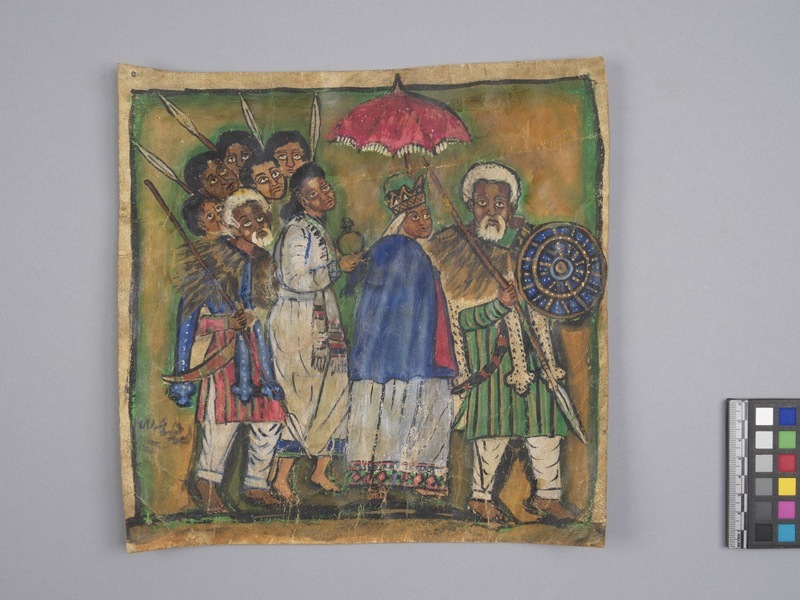Religious Procession Item Number: 3188/7 from the MOA: University of British Columbia

Description
Painting on vellum. Image is of a male walking at the front of a small procession, holding a blue and gold shield (gasha) in one hand and a spear in the other, wearing an animal skin cape over his green striped robe, and a curved knife on his belt. Empress Taytu, wearing a crown, walks behind, with a red, fringed umbrella held overhead, wearing a dark blue cloak and a garment with an embroidered hem. Next is a woman in a long white robe with a scarf, carrying a small container; then another man wearing an animal skin cape, holding a spear, with a curved knife hanging from his belt. A group of 5 men are mostly hidden from view behind him, holding spears. The background is dark orange-brown, with the figures and border outlined in green.
Narrative
This painting depicts a political procession during the reign of Emperor Menelik II. The leader of the procession is likely a general for Menelik's army and the crowned figure is Menelik's wife, Empress Taytu, shielded by a processional umbrella. In addition to establishing the capital city of Addis Ababa in 1886, building churches, and acting as patrons of the arts, Emperor Menelik II and his wife Empress Taytu were famous for resisting colonization attempts by Italy. This painting, depicting Empress Taytu, perhaps depicts a procession celebrating the Ethiopian victory at the Battle of Adwa, a historic battle in which Menelik defeated the Italian army. Folk tales credit the Empress Taytu for helping with the military's victorious strategy in this battle. It was possibly painted during a period of increased foreign tourism to Ethiopia during Emperor Menelik's reign. At this time, painting themes celebrating both the Christian heritage of Ethiopia and its military prowess became popular in Addis Adaba, to be sold to tourists.
Item History
- Made in Ethiopia before 1900
- Collected during 1972
- Owned by Edward Harvey and Lorna Marsden before July 15, 2016
- Received from Edward Harvey (Donor) and Lorna Marsden (Donor) on July 15, 2016
What
- Name
- Religious Procession
- Identification Number
- 3188/7
- Type of Item
- painting
- Overall
- height 26.2 cm, width 26.5 cm
Who
- Culture
- Ethiopian
- Previous Owner
- Edward Harvey and Lorna Marsden
- Received from
- Edward Harvey (Donor) and Lorna Marsden (Donor)
Where
- Holding Institution
- MOA: University of British Columbia
- Made in
- Ethiopia
When
- Creation Date
- before 1900
- Collection Date
- during 1972
- Ownership Date
- before July 15, 2016
- Acquisition Date
- on July 15, 2016
Other
- Item Classes
- paintings
- Condition
- fair
- Accession Number
- 3188/0007